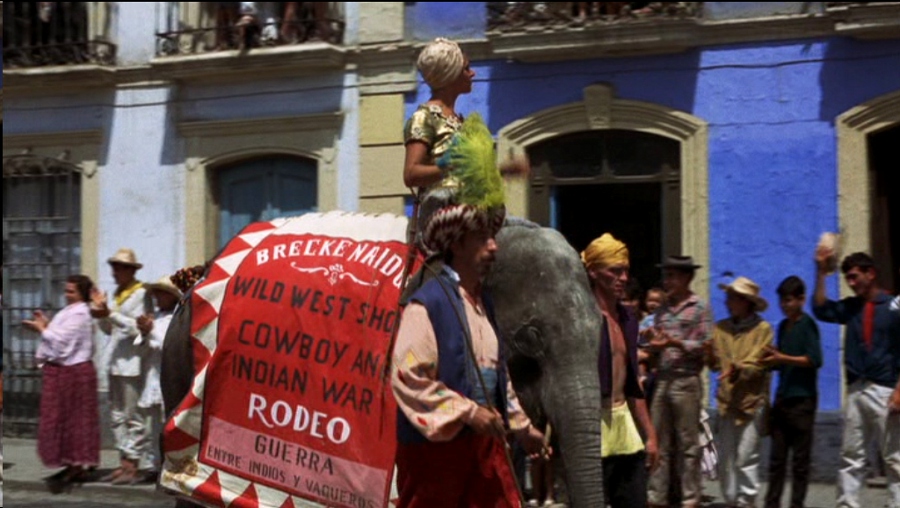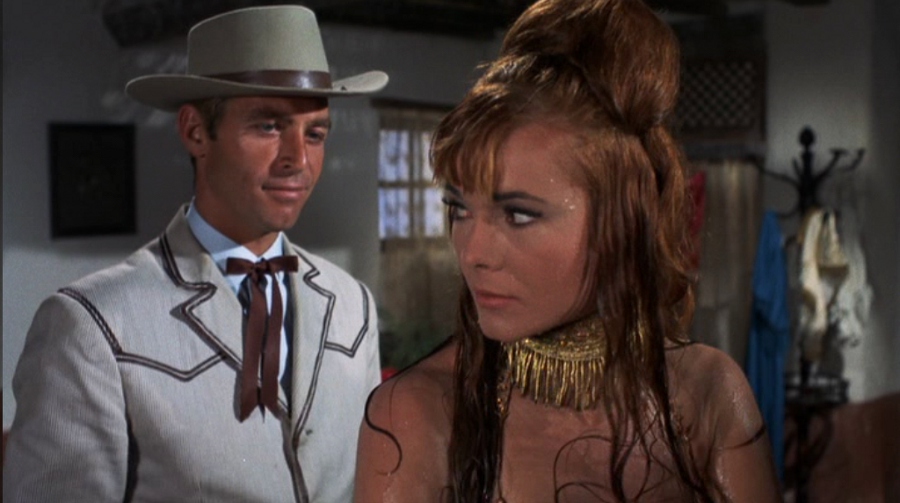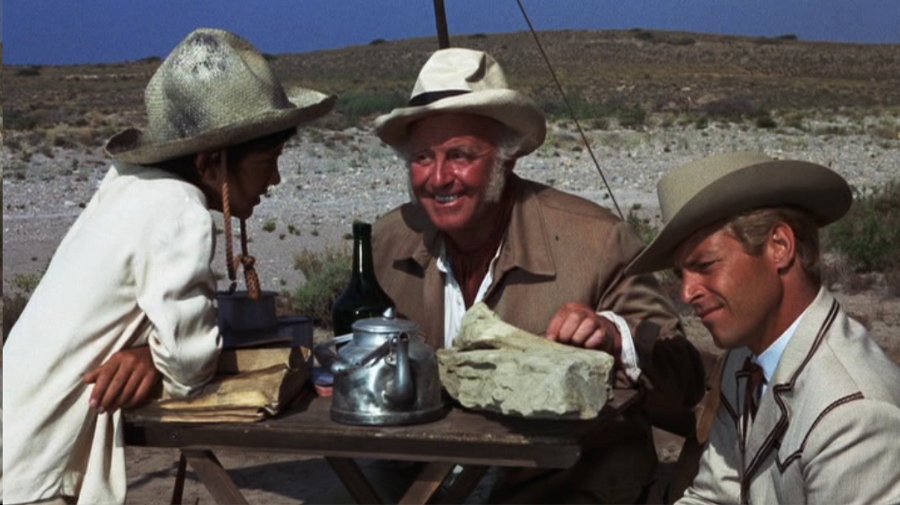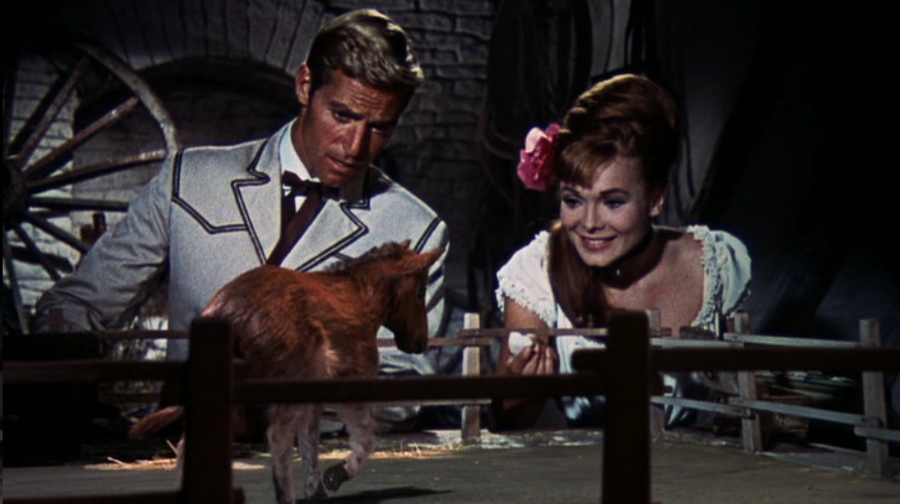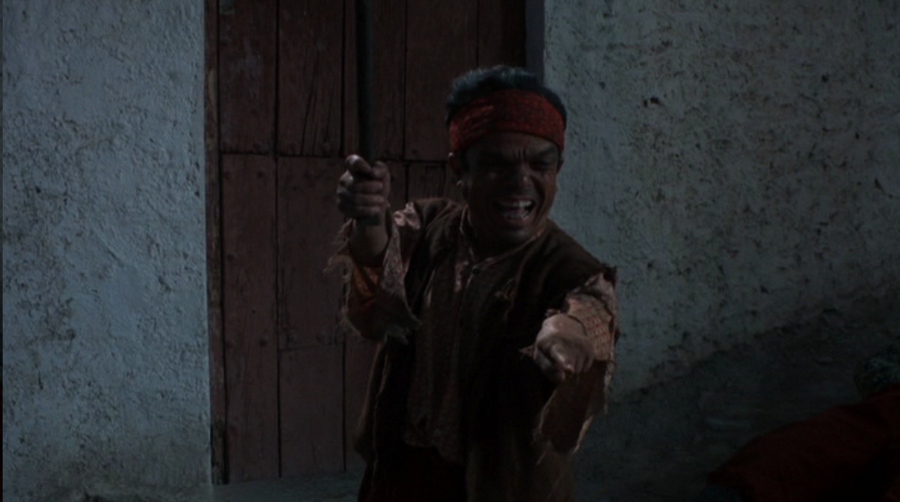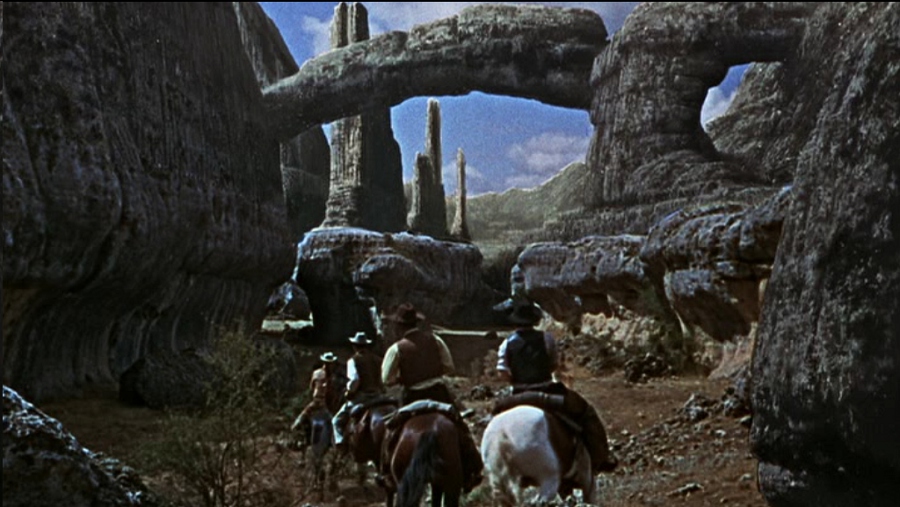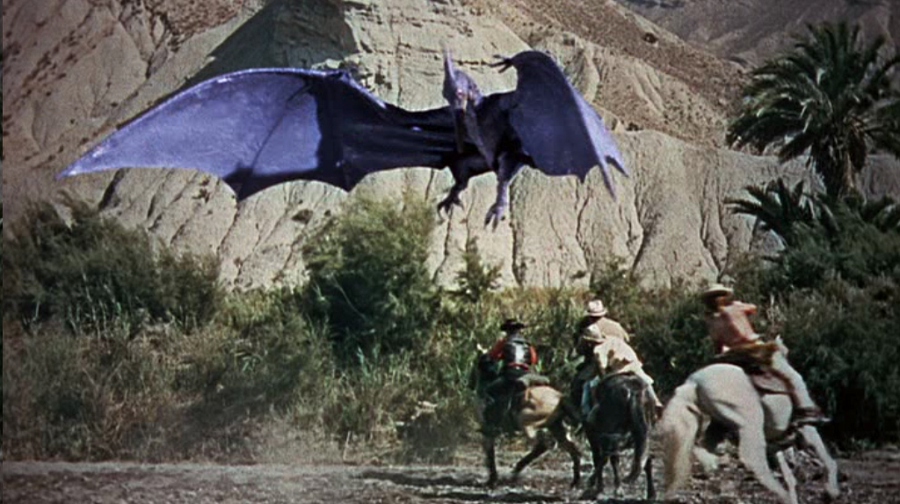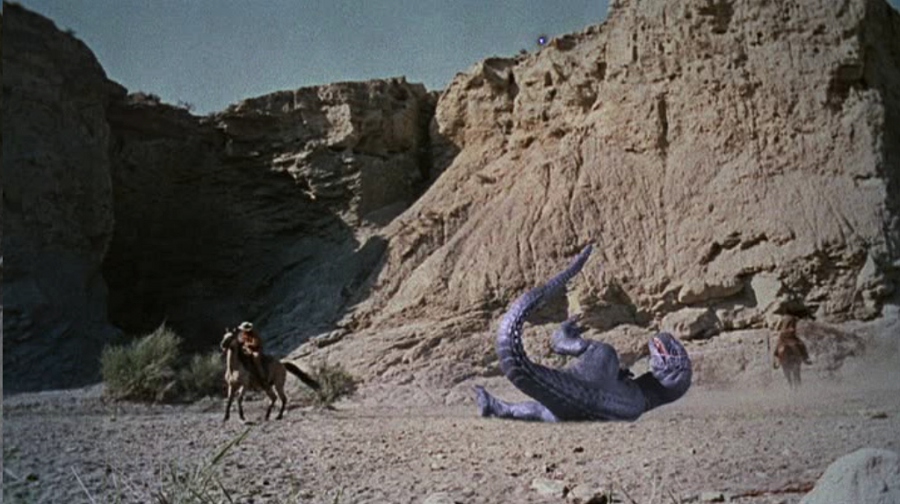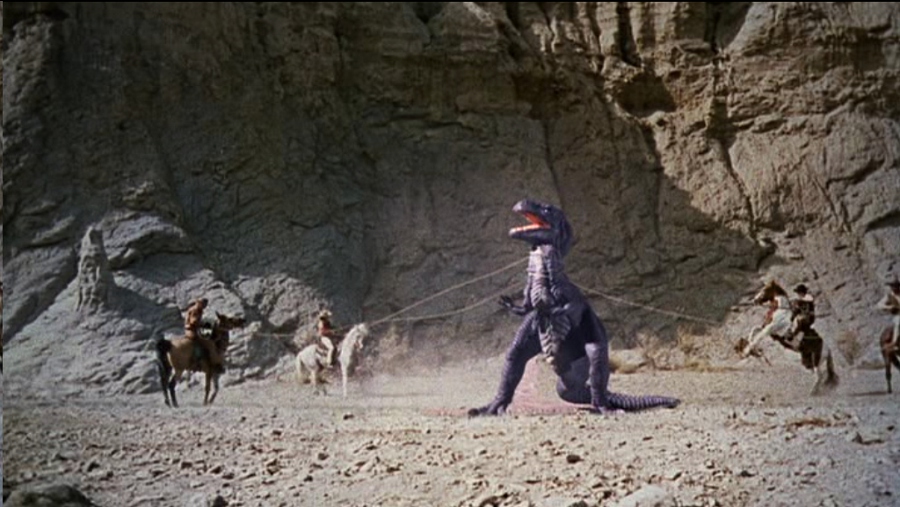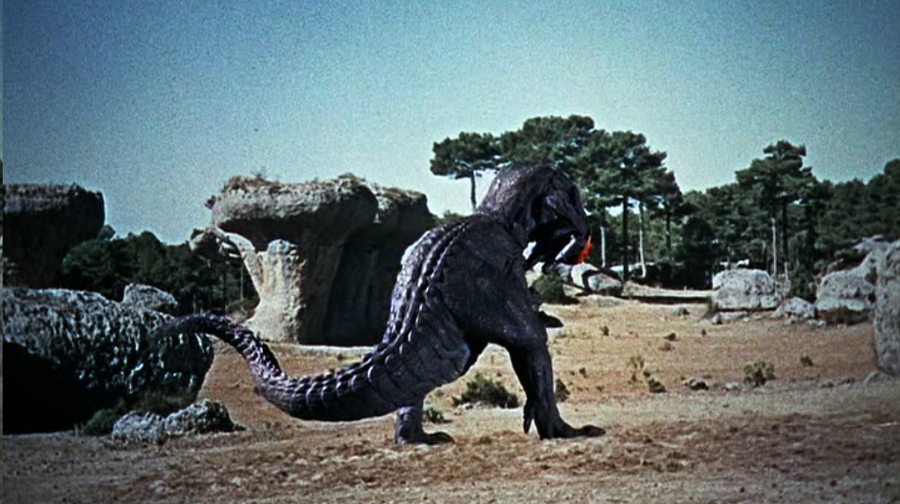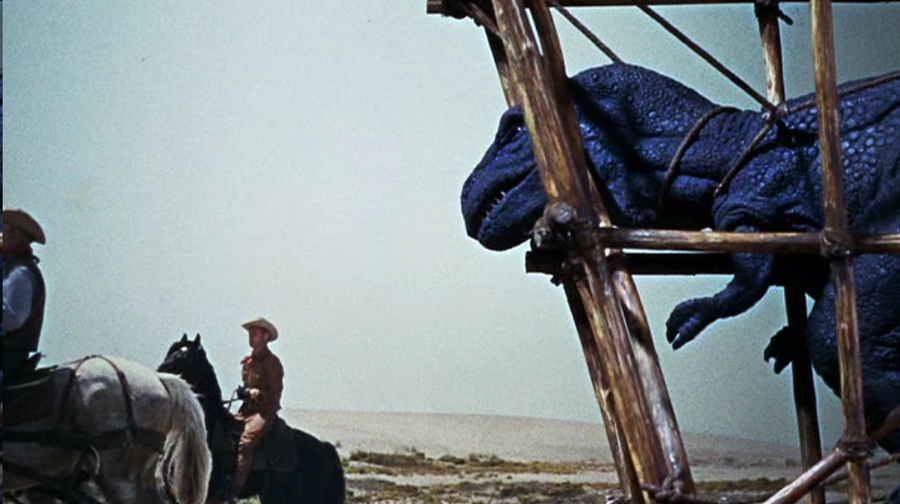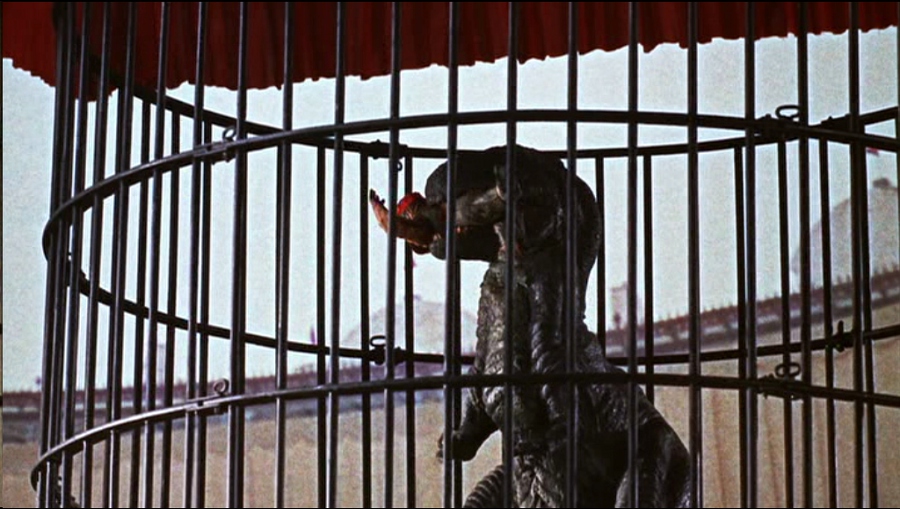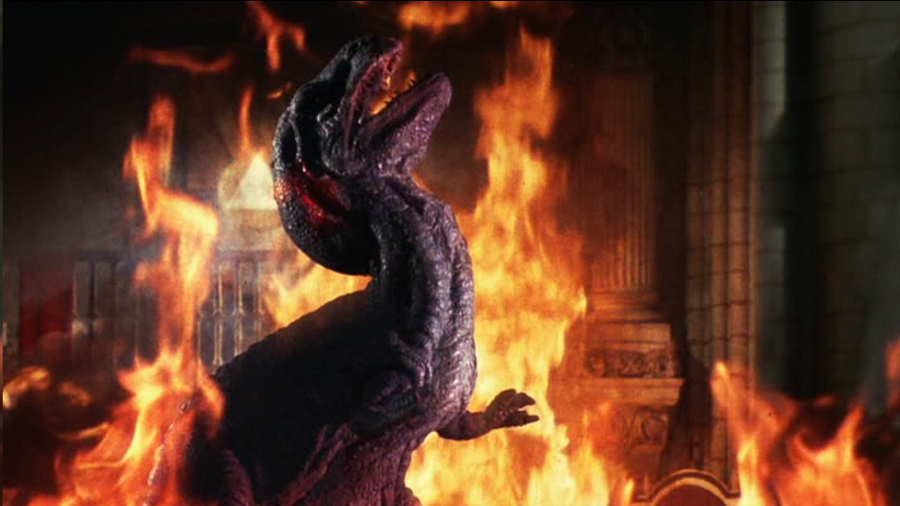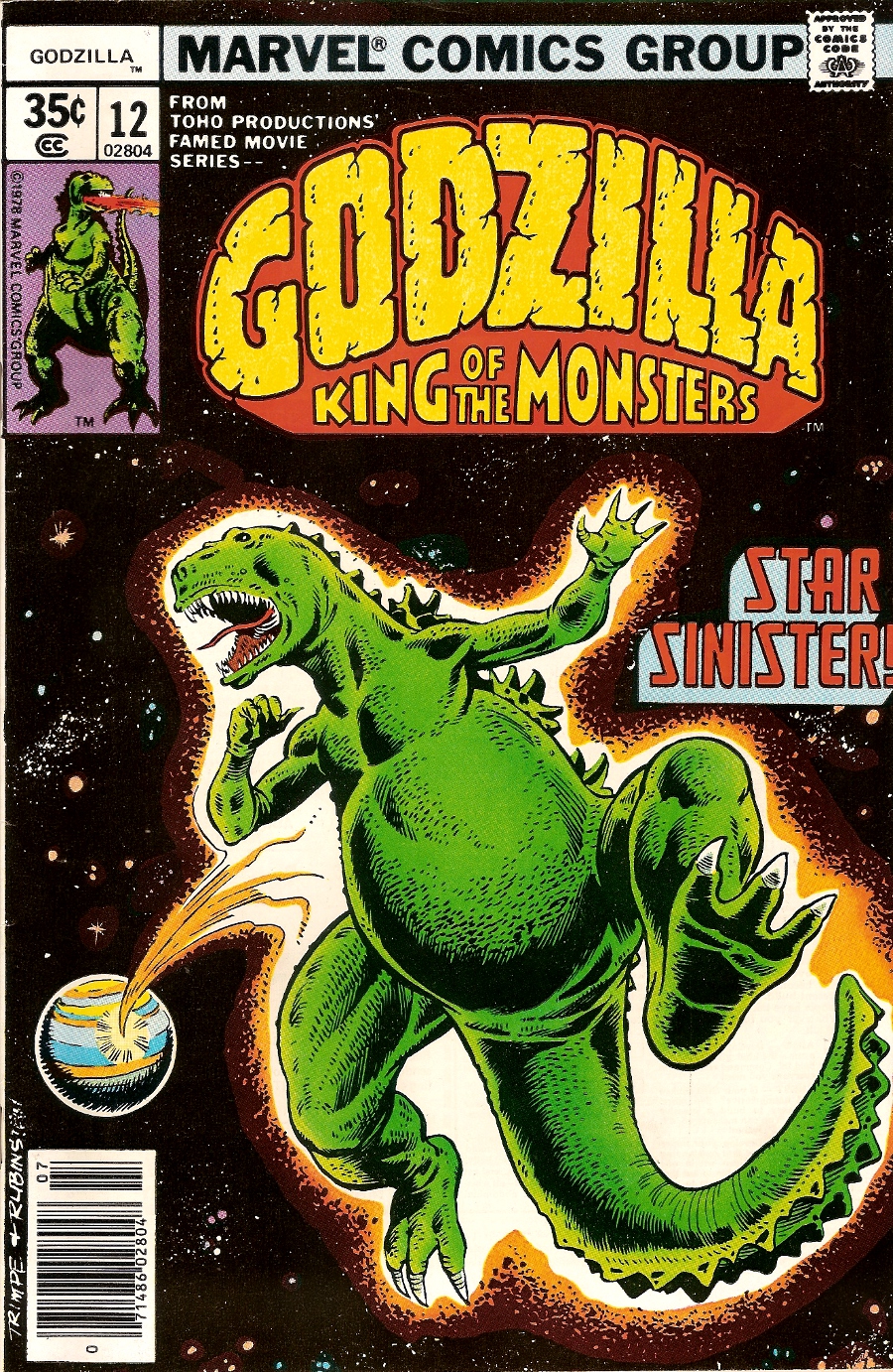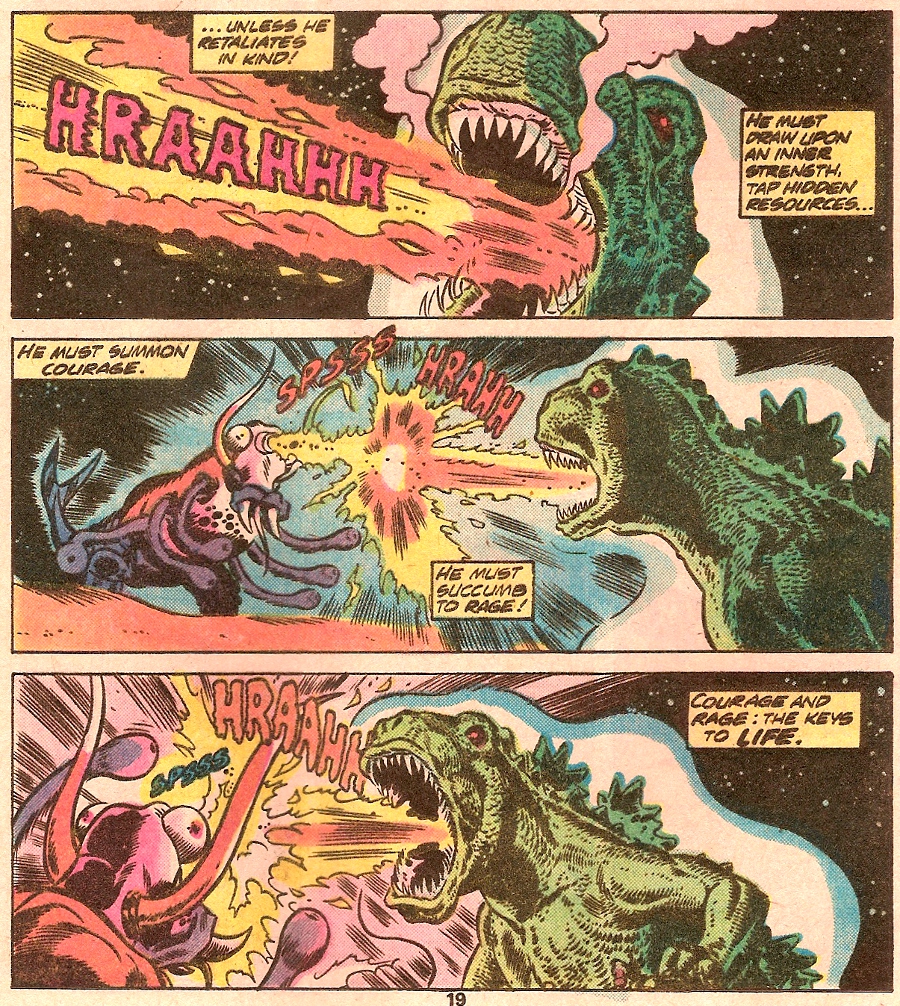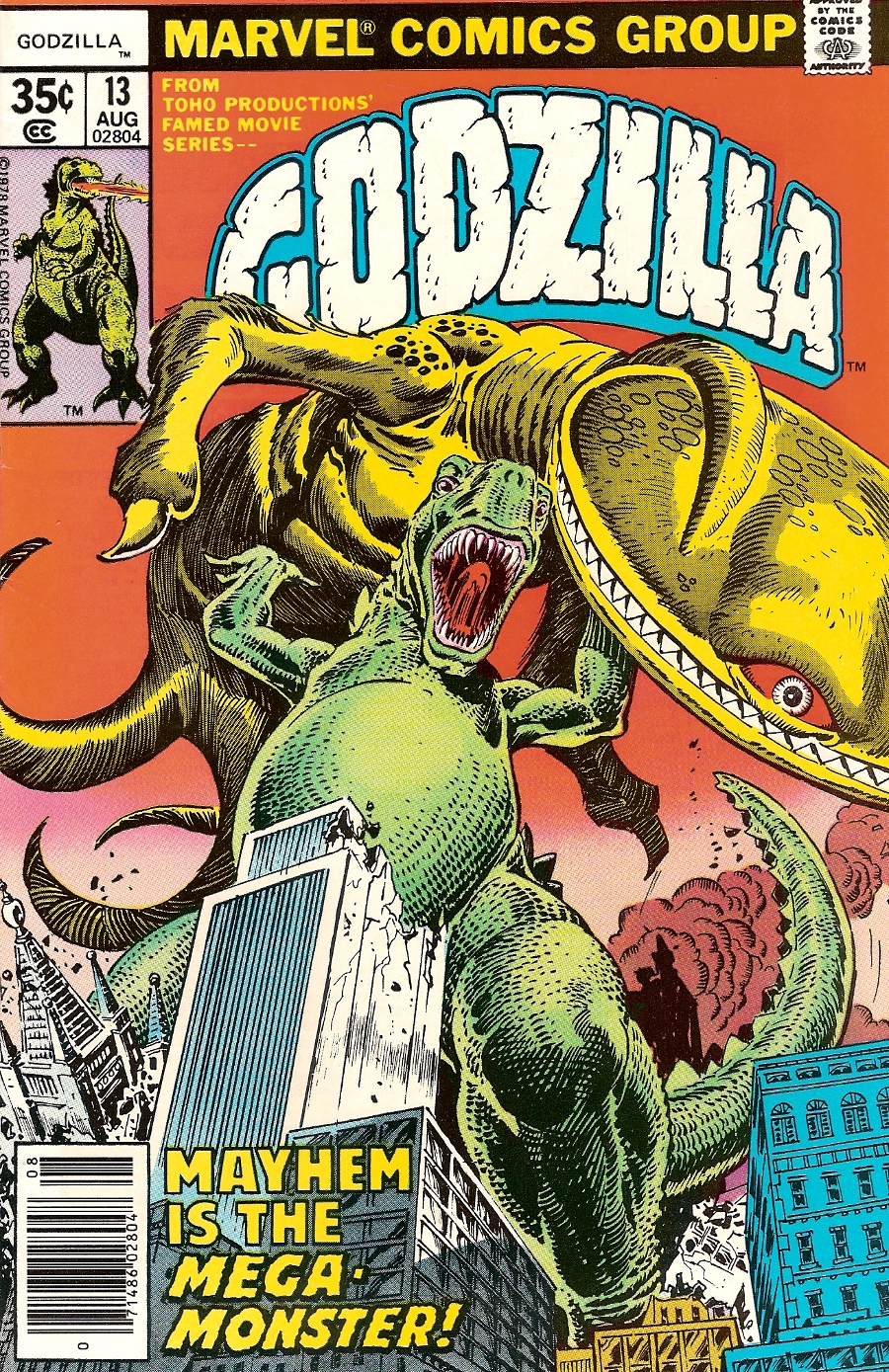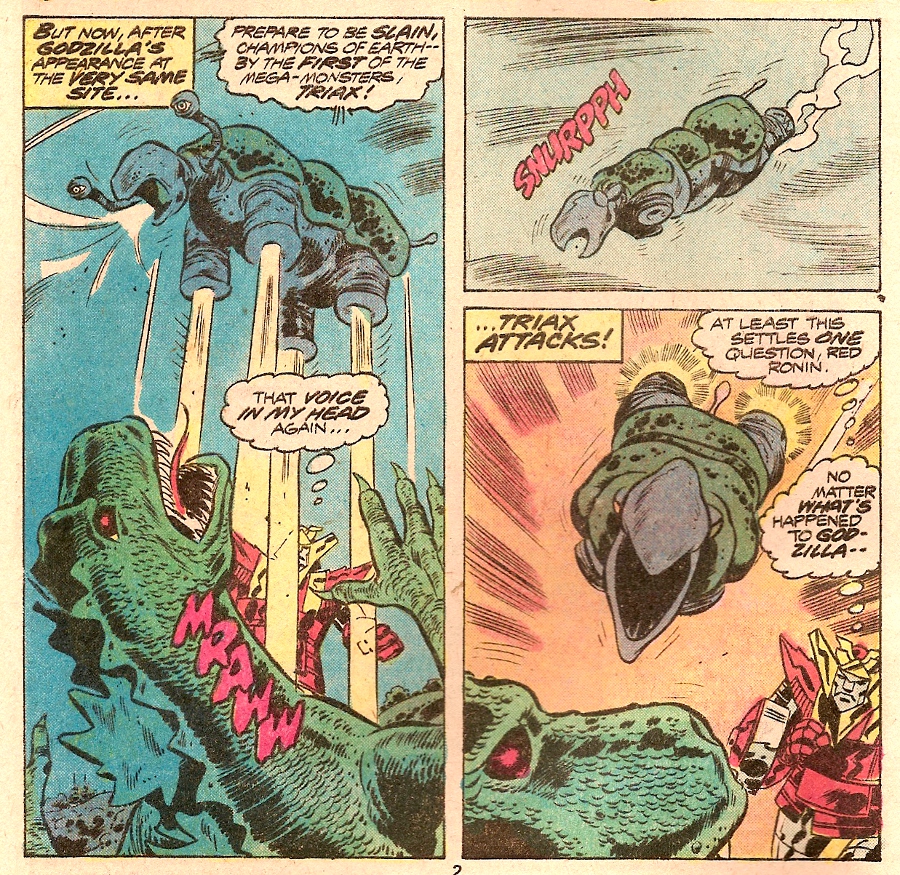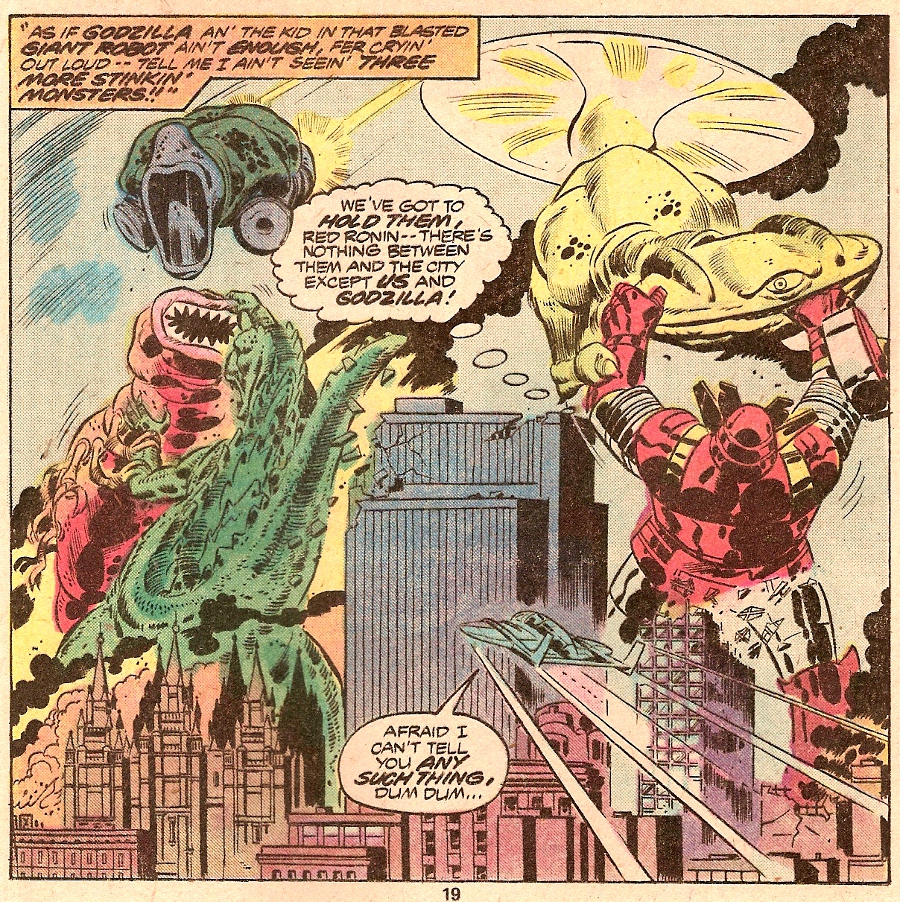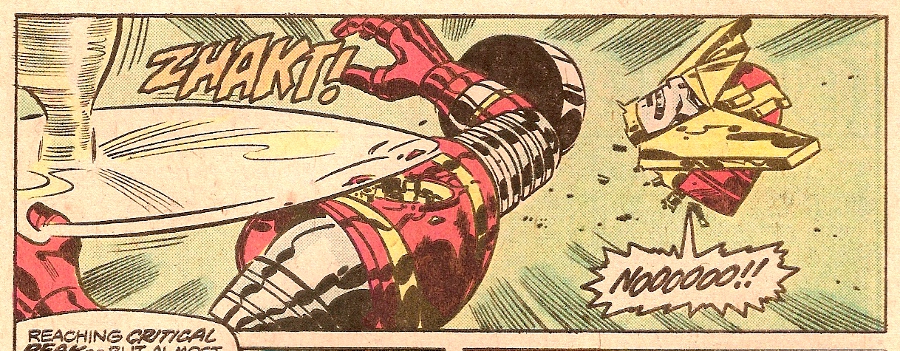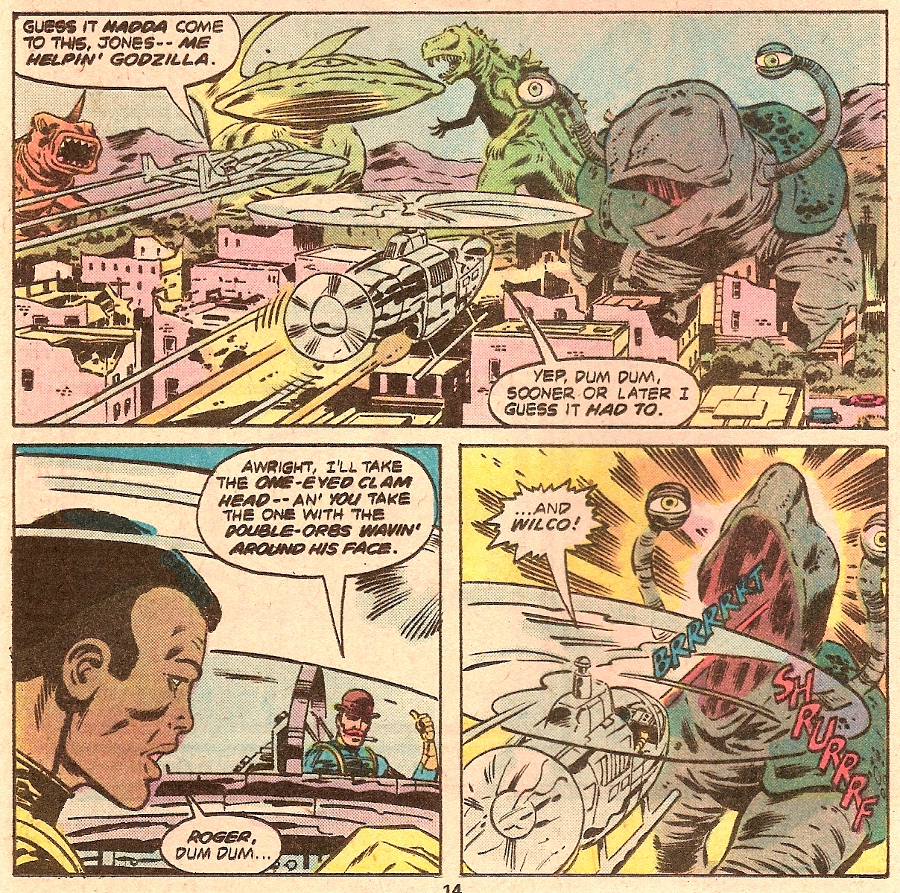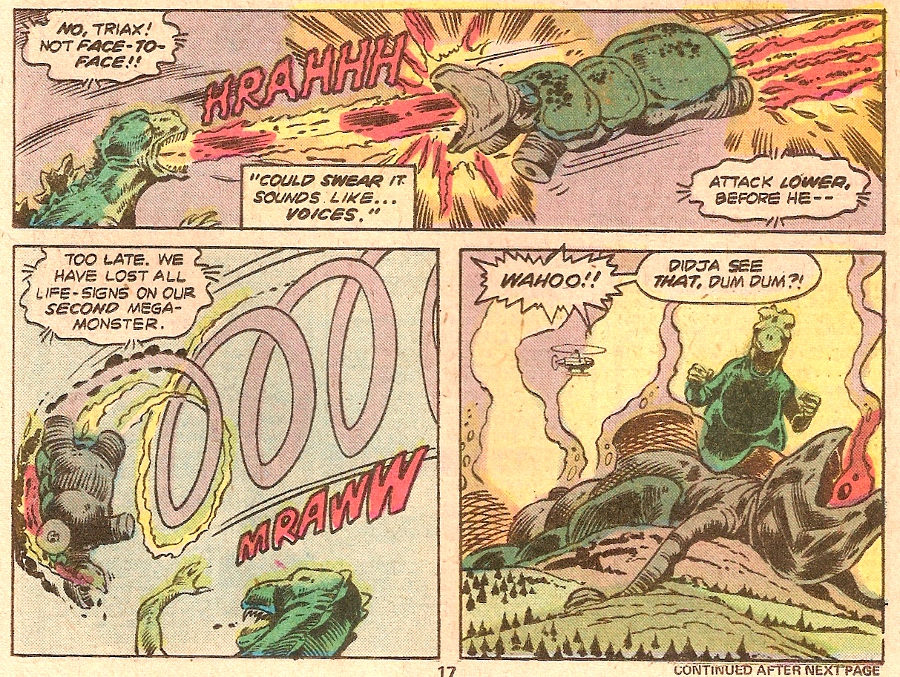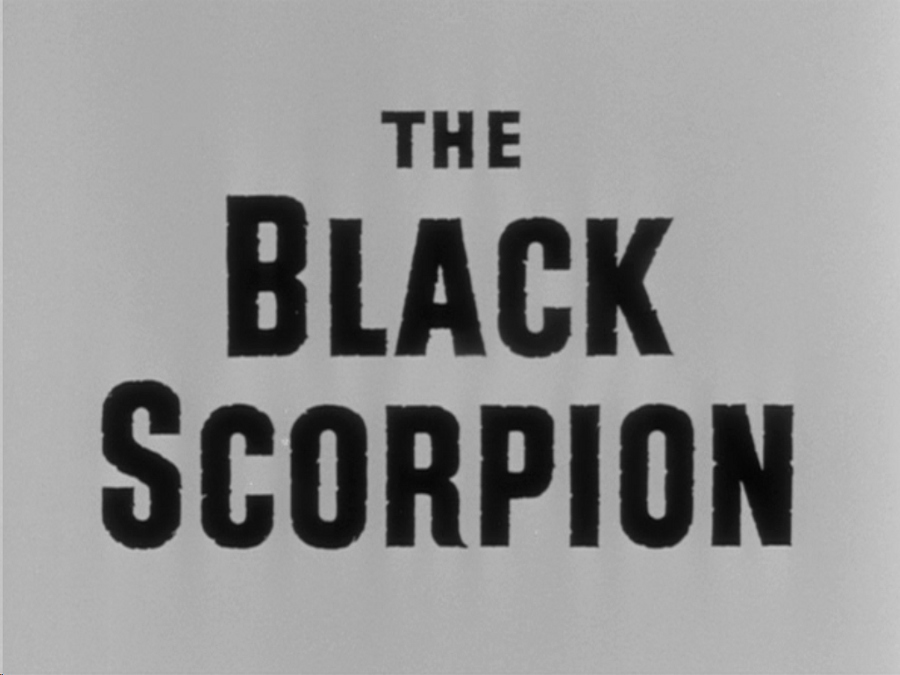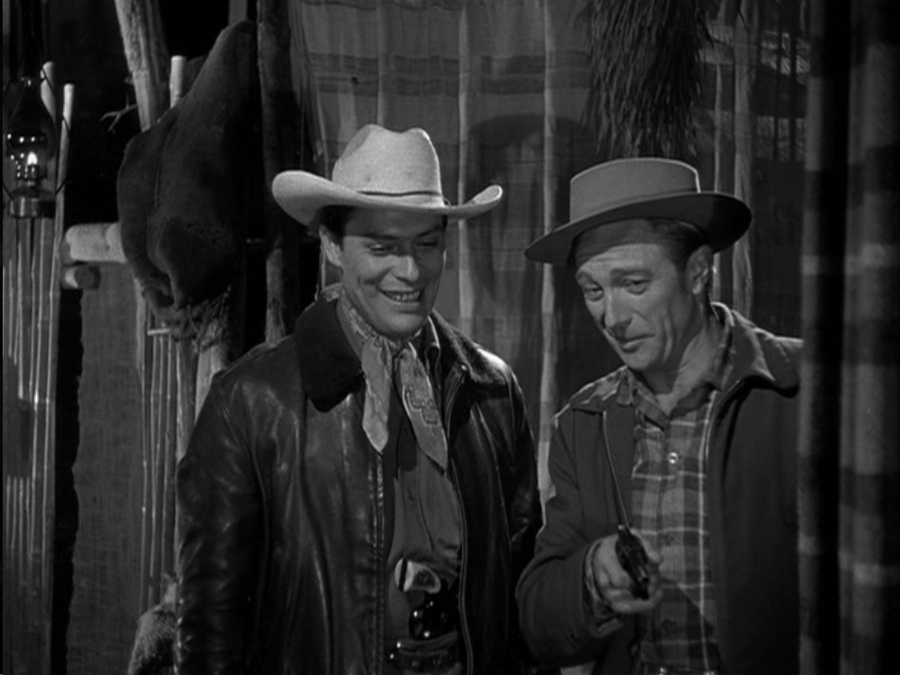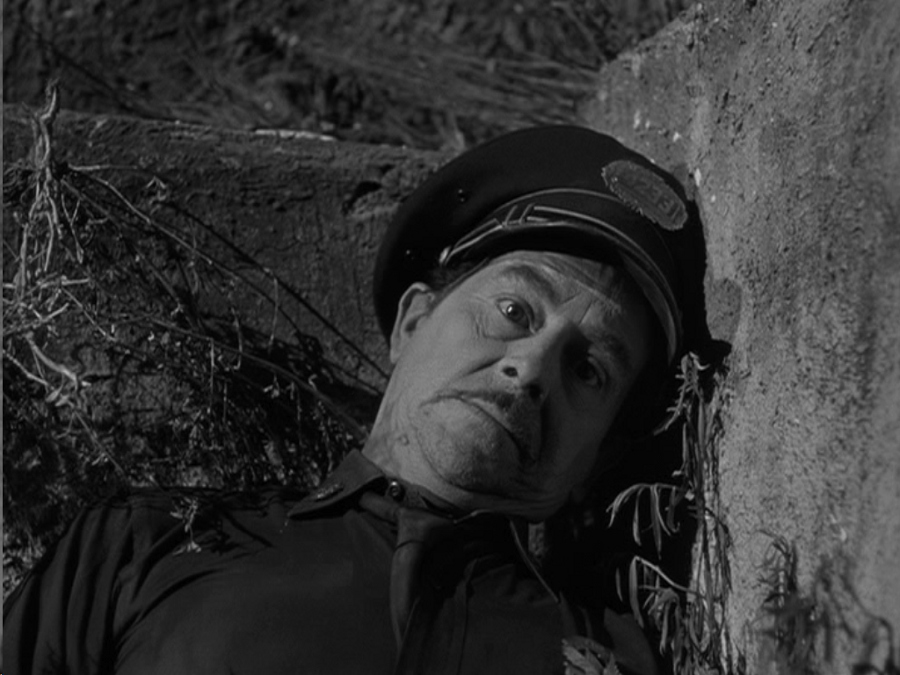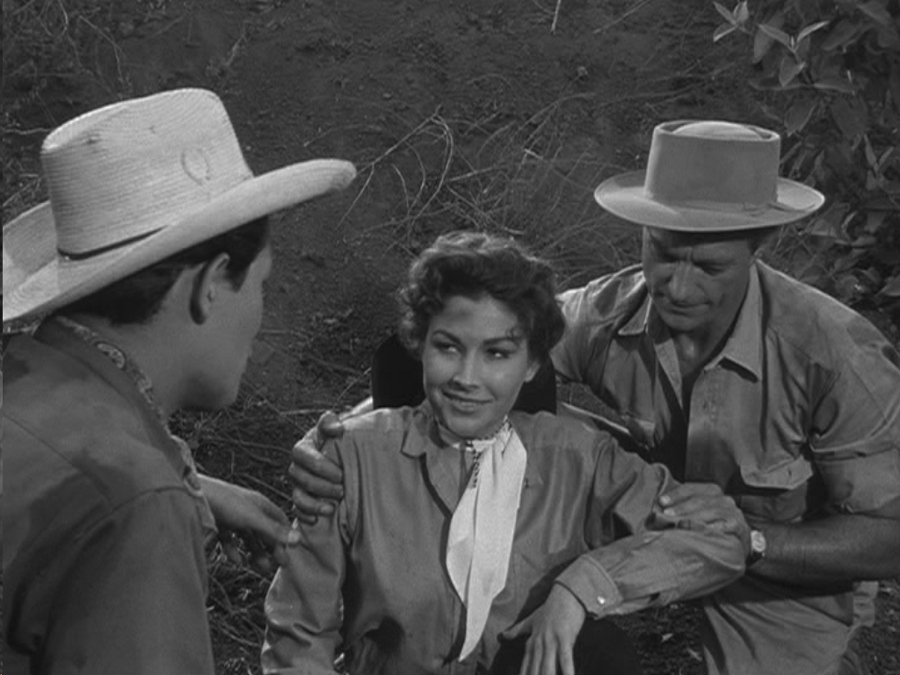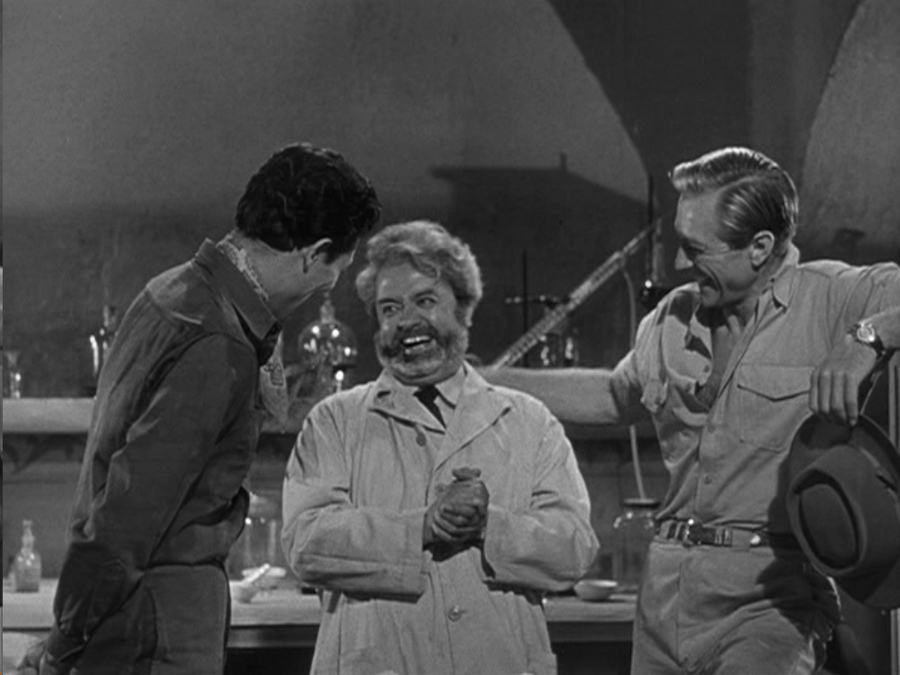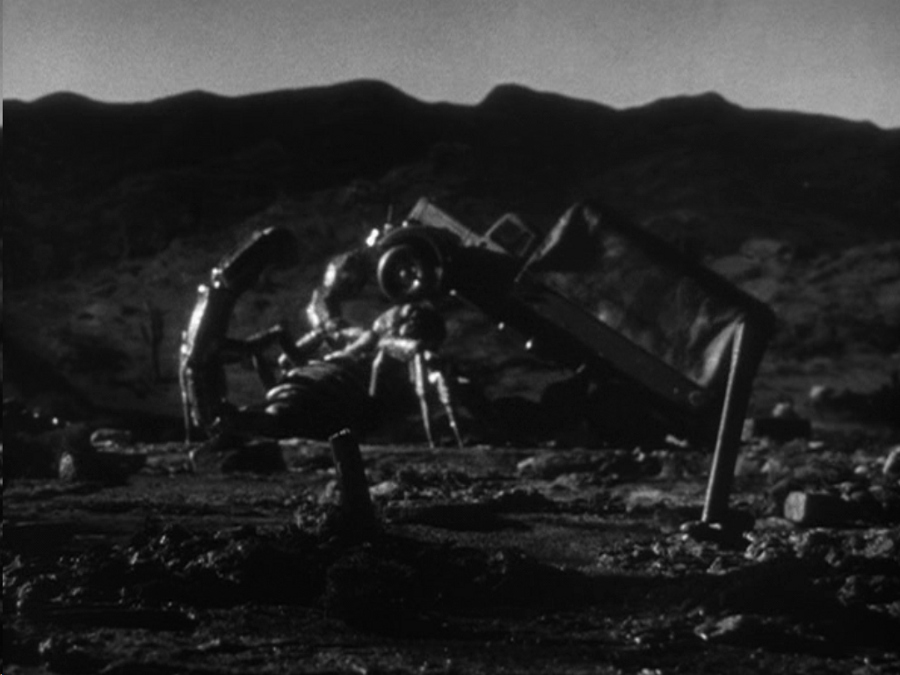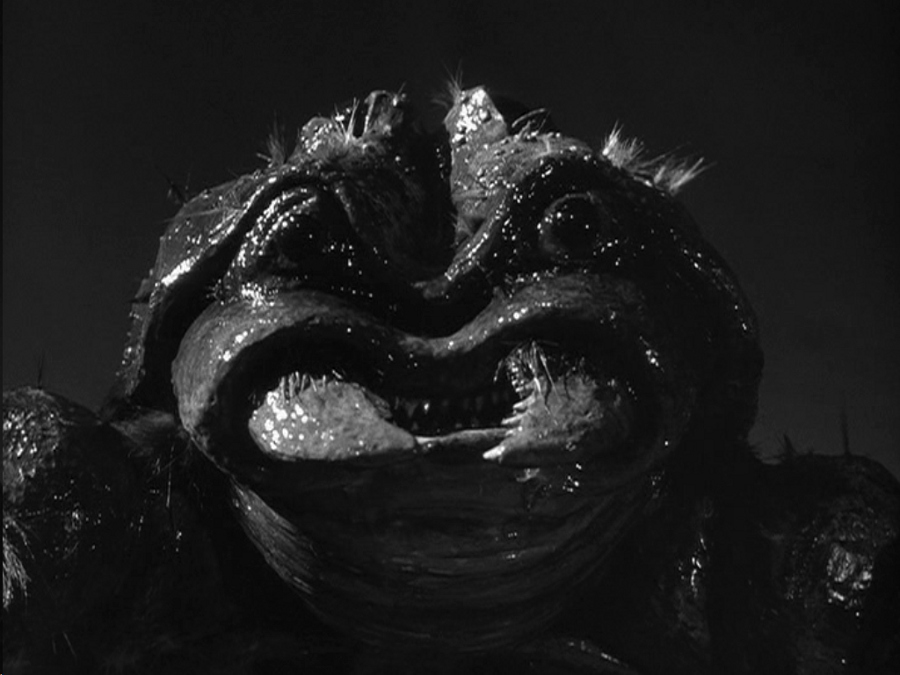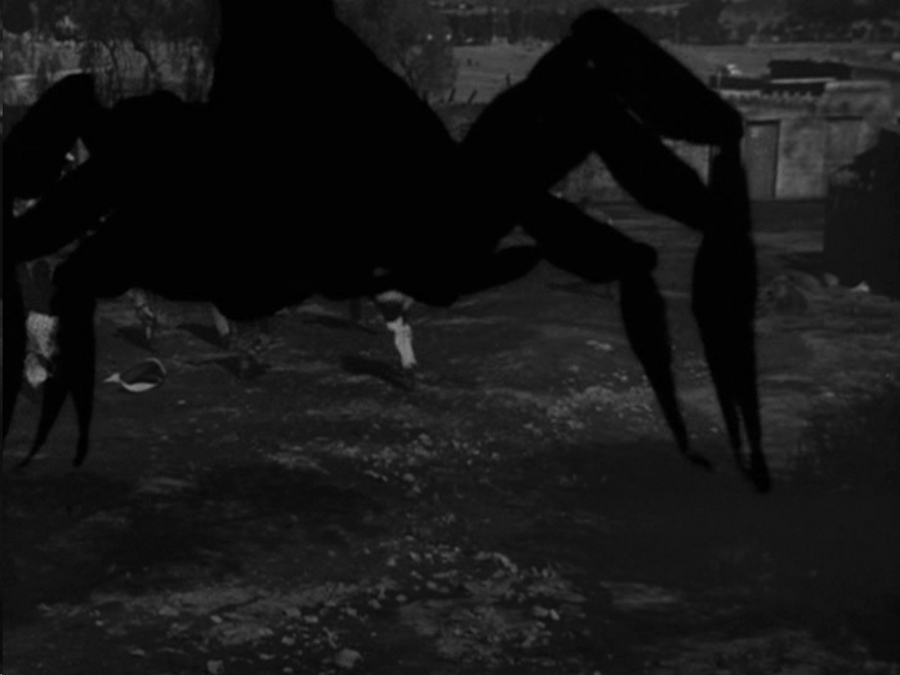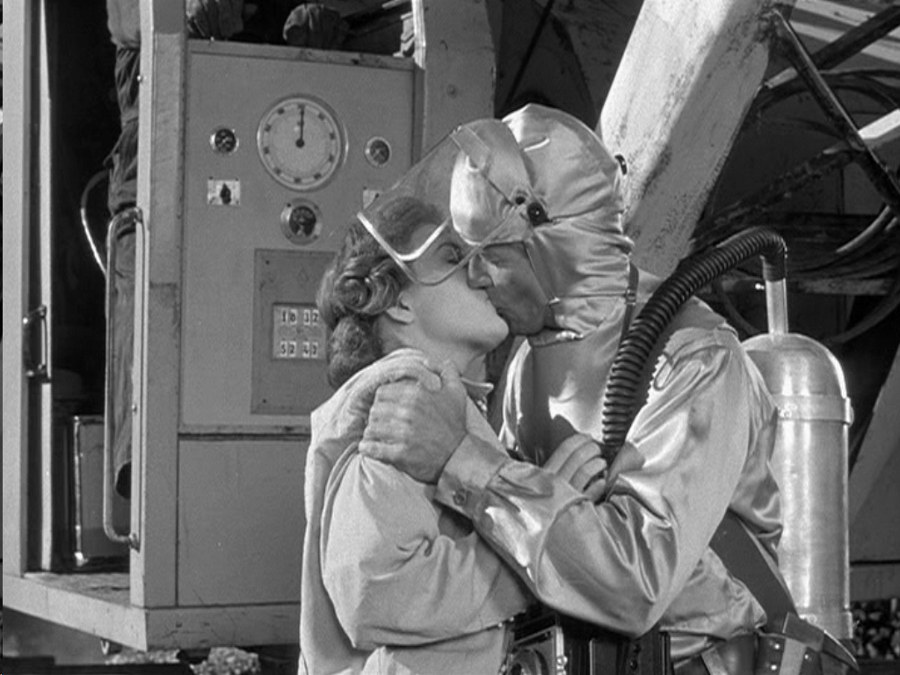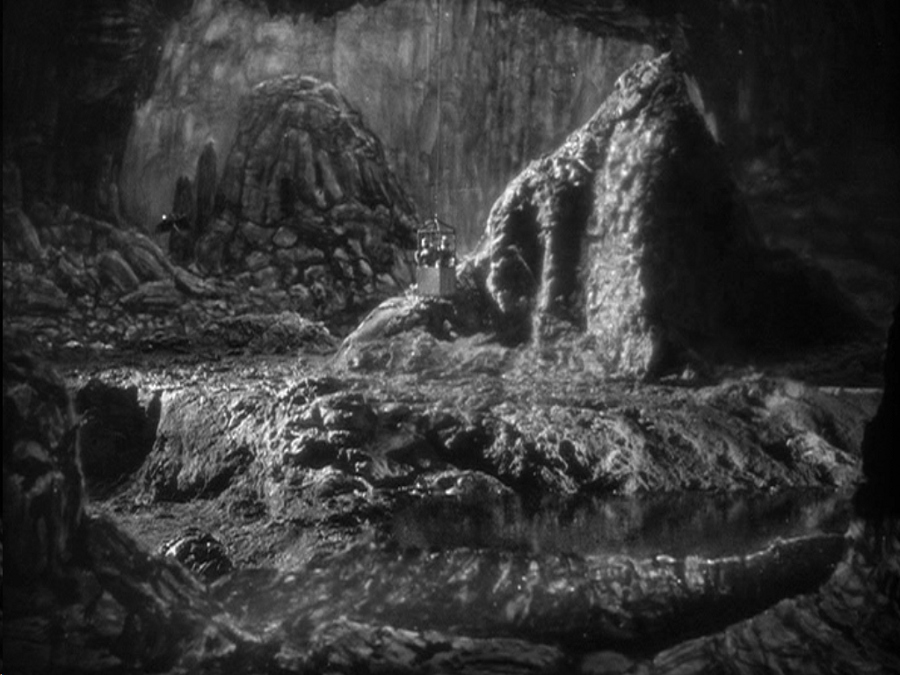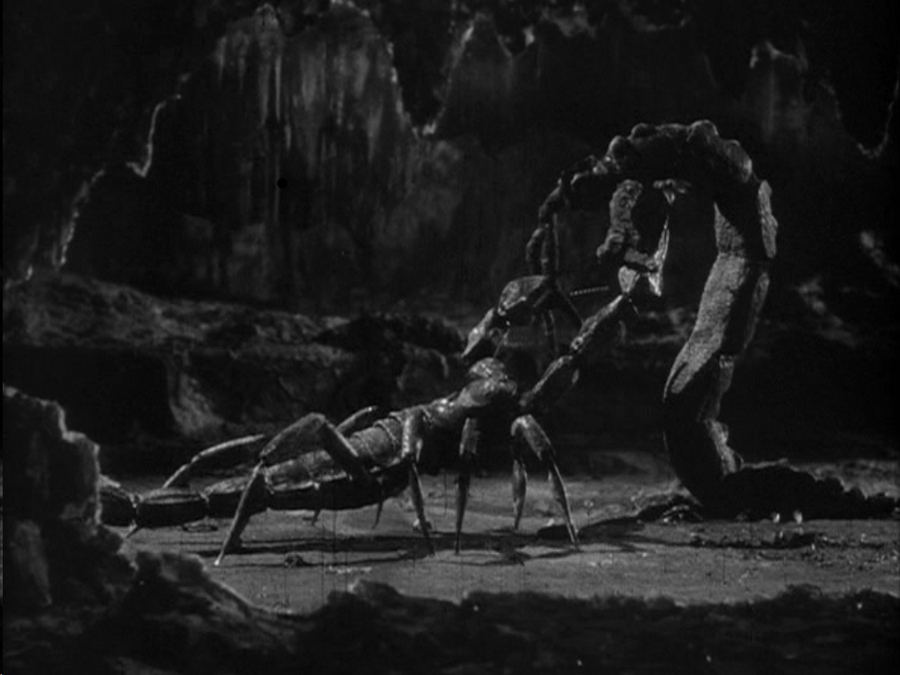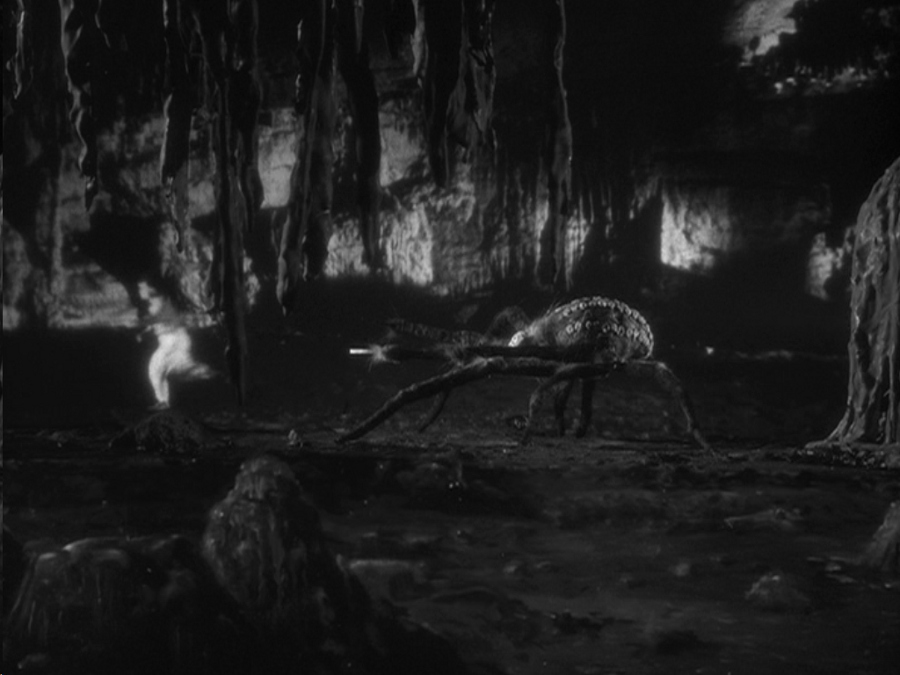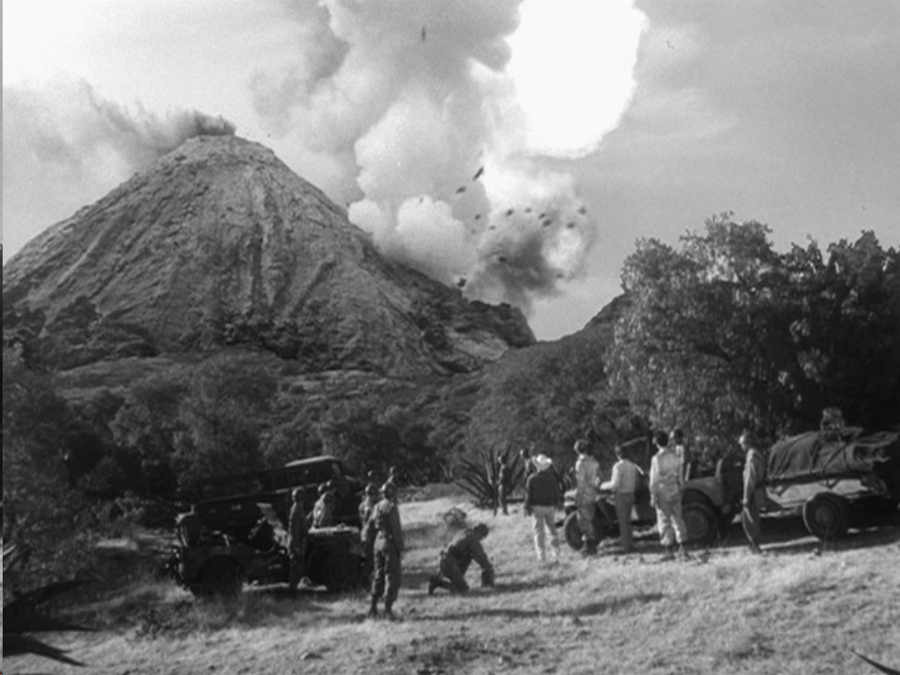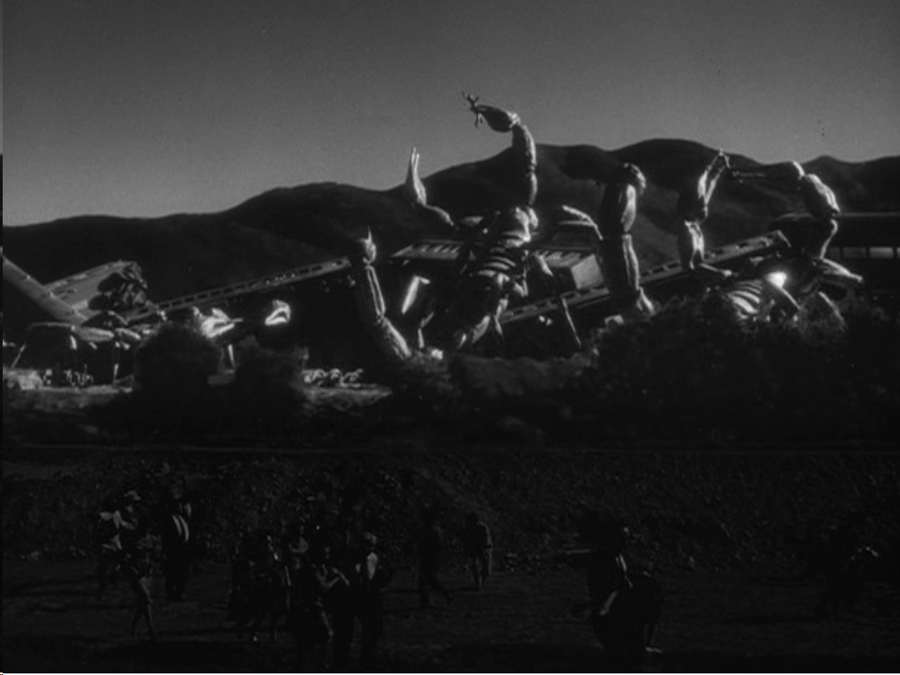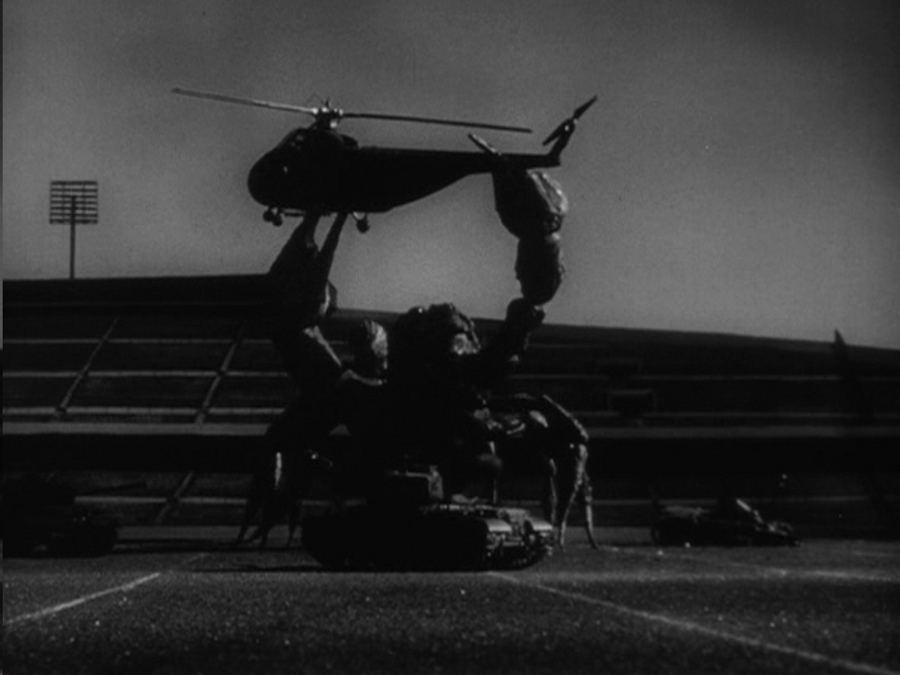Continuing with our theme of Willis O’Brien related films (that are not King Kong), we have 1969’s The Valley of Gwangi, from Warner Brothers/Seven Arts, featuring perhaps the worst studio logo in Warner’s history, a clunky ‘W’ in a shield with a horizontal bit extending from the top right to form a ‘7.’ Ghastly.
But we’re here to talk about Willis O’Brien, which may have you wondering: how can this picture be included if Willis O’Brien died years before the film was made? The Valley of Gwangi was actually a project that Willis O’Brien tried to develop before World War II. It had been in preproduction at RKO–scripts written, storyboards done, models built, principal actors cast–but like so many of O’Brien’s projects, it fell through.
Here are storyboards drawn by Obie delineating some of the major scenes (published in 1982 in Cinefex magazine #7). You may want to come back up here and compare later.
One of the major sequences proposed for Gwangi was folded into the plot of Mighty Joe Young (which we’ll discuss next week), but the rest was abandoned. A few years after O’Brien’s death on November 8, 1962 (I was exactly one week old), Harryhausen found some of the old production materials that had come into his possession and proposed the project to Charles Schneer.
The movie opens with a bloody dude stumbling to a nighttime meeting with a group of gypsies. He has something in a bag which writhes and squeals when he falls down. I wonder what was really in the bag, because it did not like landing on the rocks the way it did. He hands the bag to Carlos, one of the gypsies who is also his brother. A blind old gypsy woman tells Carlos the bag must be returned to the “Evil One,” but Carlos doesn’t listen.
Some time later, Tuck Kirby (James Franciscus) arrives in a sleepy Mexican town which is greeting the arrival of the Breckenridge Wild West Show. There are cowboys and Indians and lots of horses and for some reason, an elephant.
Notice how small the elephant is. Tuck runs into a smooth-talking orphan boy named Lope, who offers to guide Tuck around. Tuck feels a kinship with the boy’s greed and decides to hire him. Later, Tuck rides out to watch the Breckenridge show. It turns out that Tuck used to be part of the show and left under less than pleasant circumstances. We get our first brief glimpse of Harryhausen effects when the show’s owner, the beautiful T.J. Breckenridge, jumps Omar the Wonder Horse off a platform into a vat of water.
Later in T.J.’s dressing room, Tuck brings her an offer: Buffalo Bill wants to buy Omar for his show. T.J. refuses, even though her show is struggling financially. As they talk, we learn that T.J. had previously offered to sell the show and marry Tuck, but Tuck ran away, so now she hates his guts.
On the way back from the show, Tuck meets Professor Bromley, another customer of Lope’s. Bromley is a paleontologist who has found Eohippus fossils contemporaneous with humans, when Eohippus (a tiny, three-toed horse) supposedly went extinct almost 50 million years before the rise of man (Laurence Naismith, who plays Bromley, seems to go back and forth between saying “million” and “billion” at various times throughout the picture). Bromley’s kind of creepy.
Tuck goes back to see T.J. to try to change her mind. Bullfighters are rehearsing in the ring, and Lope decides to tempt the bull. Tuck saves him, but is hurt by the bull and saved in turn by gypsy Carlos, who is now a member of the Breckenridge show. Carlos regrets his heroism moments later when T.J. rushes to Tuck’s side, revealing that she still loves him. She loves him so much, in fact, that she reveals to him the secret act that Carlos has brought her, the one that will make her rich enough to ignore any offers from Buffalo Bill.
It’s a tiny three-toed horse (incongruously named “El Diablo”) that she has been teaching to dance, which rings a bell with Tuck. He later brings Bromley to see the horse, which Bromley recognizes as a living Eohippus. Bromley realizes that the real issue is not El Diablo, but where he came from, because where there’s one, there must be more. Bromley goes starry-eyed at the possibility of scientific prizes, while Tuck sees a fortune to be made.
Unfortunately, their path to El Diablo runs through Carlos, who is upset that T.J. betrayed their secret to Tuck. But Carlos lets slip that the gypsies led by crazy blind Tia Zorina know where the horse came from. So Tuck gets Lope to track down the gypsy camp, where Tia Zorina refuses to help him. But after Tuck leaves, Professor Bromley tells Tia Zorina where El Diablo is being kept, and the next night, the gypsies strike.
Never turn your back on a giggling midget with a crowbar. Just sayin’.
Carlos is knocked out, but comes to in time to see Tuck race off after the gypsies, leading him to accuse Tuck of being the thief. So Tuck and Professor Bromley chase the gypsies, pursued in turn by T.J. and her most loyal cowboys. They all have a confrontation just outside a ring of forbidding mountains, where they spot El Diablo having a chat with one of their horses.
El Diablo runs away into a small opening in the cliff wall, which turns out to lead into a hidden valley. They widen the opening to fit their horses through and cross into another world (and if you’re keeping time, this is almost exactly halfway through the movie). The valley is both alien and awesome.
T.J., Carlos, Professor Bromley, and Lope are attacked by a pterodactyl that grabs Lope right off the back of Bromley’s horse.
This is a standard Harryhausen pterodactyl, which is to say, it isn’t really a pterodactyl at all. Pterodactyls had one long finger and an unbroken flap of skin between that finger and their torso. Harryhausen felt that single flap of skin looked too flimsy for actual flight, so his pterodactyls always have bat wings.
The pterodactyl tries to fly off with Lope, but he is too heavy, so the pterodactyl crashes back to Earth. Some folks point this out as a logic flaw in the movie, since the night before, a pterodactyl carries away Lope’s mule, which far outweighs him. But there’s nothing in the picture which identifies this as the same pterodactyl. Anyway, Carlos jumps on the thing’s back and wrestles it, just like the bulls back in town (and compare this shot to the storyboards above).
Say, does Carlos’s shirt look a little… red to you? I’m sure it’s nothing. He breaks the pterodactyl’s neck. Meanwhile, Tuck and the other cowboys spot a small dinosaur (one of the cowboys says its a Pluktostrich and it takes a moment to realize he actually said, “plucked ostrich”) and try to catch it for the show. But something else catches it first.
Meet Gwangi. It’s an awesome entrance. He chases the cowboys  back to where they meet up with the other half of their party, and everyone flees (except the professor). But the dead pterodactyl and a territorial Styracosaurus convince Gwangi to go back and have a peaceful lunch instead.
The group holes up in a handy cave to spend the night. T.J. offers once again to sell the show and marry Tuck, and this time, Tuck agrees, provided they move to Wyoming and start a ranch, giving up show business altogether. Ah, love.
The next morning, Tuck goes out to fetch water and encounters Gwangi instead, who pauses to scratch his face.
And if you’re wondering why this is significant, go read about it here (scroll halfway down the story for the discussion in question). I’ll wait.
Gwangi chases Tuck back to the cave, where the cowboys try to protect Tuck by roping Gwangi. Â This is the crown jewel of the movie’s effects scenes, a beautiful piece of work by Harryhausen. Once again, compare these screencaps to the storyboard drawings above.
Of course, one reason Harryhausen was able to pull this scene off was that he had done much the same thing before, as we’ll see next week. But eventually, Gwangi is able to chew free of the ropes just as the angry Styracosaurus arrives to find out what all the noise is about and yell at everybody to get off his lawn.
Gwangi and the Styracosaurus get into a fight, which Carlos helps determine the outcome of when he spears one of the combatants, apparently practicing his picador skills. And here’s the last of the storyboard comparison moments (notice in the storyboard, Gwangi is actually fighting a Triceratops, not a Styracosaurus).
Gwangi wins the fight, and our heroes have to flee right past him, because Carlos has also started a brush fire that drives them away from the cave. That Carlos… It’s almost like he’s cursed, or something. The old lady did say something about him being cursed for taking the Eohippus away. Or maybe it’s the color of his shirt.
Definitely the shirt.
The group minus Carlos escapes through the narrow passage out of the valley with Gwangi in hot pursuit, but in trying to squeeze through the narrow opening, Gwangi starts a rockslide that knocks him cold. Immediately Tuck and Champ, T.J.’s foreman, decide to take Gwangi back to civilization and put him in the show. And before you can say, “This is exactly the plot of King Kong, which was exactly the plot of The Lost World, because apparently Willis O’Brien only had about three ideas in his entire life that he kept repeating ad infinitum,” that’s exactly what they do. They build a giant cart and haul Gwangi back to town.
But it turns out that hardly anybody’s happy about it. Bromley is upset that Gwangi is being exhibited for profit rather than turned over to the Royal Society in England so that he can receive a knighthood. Tuck is unhappy that T.J. has decided to take Gwangi on a world tour rather than retire to Wyoming with him. And the gypsies are pissed that Gwangi is now a prisoner instead of an evil god.
And now it’s showtime. But first, we get to see a little of the opening act: the elephant (remember him from way back in the beginning?) Only now he’s freaking huge, so big that the production literally could not find an elephant big enough, so Harryhausen had to animate it.
So Tia Zorina sends her creepy midget henchman to remove the giant steel pins holding Gwangi’s cage together. Which means that when the curtain goes up to reveal Gwangi, he’s busy having a little snack.
Gwangi busts out of the cage, and everyone panics. Bromley is crushed by the falling cage, and creepy old Tia Zorina is trampled to death by the fleeing crowd. Gwangi then gets into a fight with the elephant, because why even have a gigantic elephant in your Wild West show if it’s not going to fight a dinosaur? It’s not like it’s a Prairie Elephant.
Then of course, Gwangi storms out of the arena and runs wild in the streets. He chases the fleeing crowds into the cathedral, only everybody runs out the back way, leaving Gwangi alone, except for Tuck, T.J. and Lope.  Tuck sets the building on  fire (and seriously, this cathedral is huge, even bigger than the one in Daredevil, only it’s even more out of place in this empty nothing nameless Mexican village) and escapes with the others. Gwangi dies screaming.
Poor Gwangi. And poor townspeople, because seriously, that cathedral must have cost them pretty much every centavo the town has made for the past century or so. And poor T.J. and Co., because as soon as the fire dies down, nobody’s going to be very happy with them. Somewhere in Hell, Carlos is laughing.
And that’s it. The Valley of Gwangi is often dismissed by casual fans, because it’s not very original, and visually, the live action portions feel almost more like a TV series than a feature film. And the most technically complicated effects sequence, the roping of Gwangi, doesn’t look all that impressive. It’s seamless, but not spectacular.
But The Valley of Gwangi is, for me at least, one of the better Harryhausen movies overall (considering that, effects aside, all of Harryhausen’s movies are pretty mediocre). It’s fun to watch, and the simple story is pretty well handled. And Gwangi is fierce.
I especially like the way that basically the entire story is driven by guys wanting to get into T.J.’s pants. Carlos defies his own people’s curse out of his unrequited crush on her, and Tuck’s feelings for her set the rest in motion.
Next week: Mr. Joseph Young of Africa.




